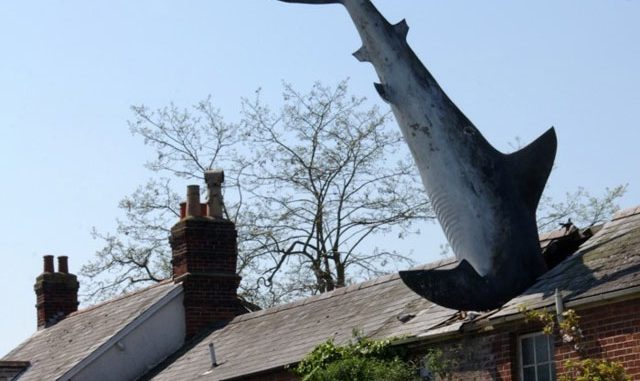by Theodore Dalrymple

I can’t say that I would be particularly pleased if my next-door neighbour affixed a large fibreglass great white shark apparently diving into his roof, but time lends charm to eccentricities and there is no doubt that the model shark that Mr Bill Heine affixed to the roof of his house in Headington, Oxford, thirty years ago, continues to raise a smile and attract visitors’ attention. The question has now arisen as to whether it should be listed as some kind of local or national worthy of preservation, to prevent it from being demolished and removed.
It is a difficult question. I think I would be inclined to ask people in the neighbourhood, but probably no very clear answer would emerge. Some would want it to go, some to stay. I like the idea of eccentricity, but not of eccentricity that is too much of an imposition on others. In this case, I am inclined to the side of preservation: it cannot surely be long before no one who detests the shark will have to live in sight of it. If they don’t like it, they can live elsewhere. The shark could even be construed as a symbol of freedom, and heaven knows, we could do with a few of those these days.
However, fixation on the shark question should not blind us to the malign and frequently corrupt eccentricities of our system of preservation. The authorities in charge of preservation often bully owners of listed houses in matters of tiny detail, at great cost to those owners, while simultaneously allowing for the wholesale desecration of whole townscapes. Anyone who doubts this phenomenon should take a look (just as one example among many) at Imperial Square in Cheltenham, where a criminally hideous tower office block has been permitted to ruin the outlook of a graceful Regency terrace once and for all.
The preservation order on the satanically bad and destructive work of Ernö Goldfinger, or the on the preternaturally vile signal box at Birmingham New Street Station built in 1966, are attempts to persuade us that there is something more to these buildings than scours the eye: that we should celebrate, to use a modern word, the incompetence, malignity and destructiveness of modern British architects. It is true that one of their buildings should be preserved, to remind us of how bad architecture can be: but one is enough.
First published in Salisbury Review.
- Like
- Digg
- Del
- Tumblr
- VKontakte
- Buffer
- Love This
- Odnoklassniki
- Meneame
- Blogger
- Amazon
- Yahoo Mail
- Gmail
- AOL
- Newsvine
- HackerNews
- Evernote
- MySpace
- Mail.ru
- Viadeo
- Line
- Comments
- Yummly
- SMS
- Viber
- Telegram
- Subscribe
- Skype
- Facebook Messenger
- Kakao
- LiveJournal
- Yammer
- Edgar
- Fintel
- Mix
- Instapaper
- Copy Link









One Response
This sort of decoration is very common in the States on stores, especially restaurants, but not residences. Looks fishy to me.